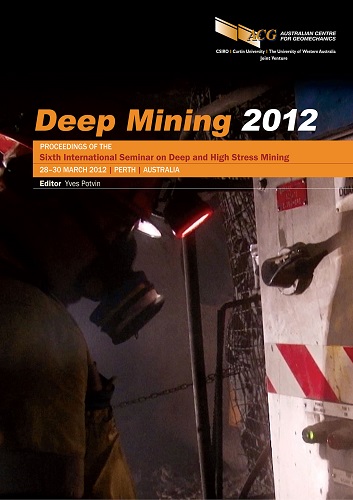Mechanisms of rockbolt support in jointed rock masses

|
Authors: Moyo, T; Stacey, TR |
DOI https://doi.org/10.36487/ACG_rep/1201_06_moyo
Cite As:
Moyo, T & Stacey, TR 2012, 'Mechanisms of rockbolt support in jointed rock masses', in Y Potvin (ed.), Deep Mining 2012: Proceedings of the Sixth International Seminar on Deep and High Stress Mining, Australian Centre for Geomechanics, Perth, pp. 91-103, https://doi.org/10.36487/ACG_rep/1201_06_moyo
Abstract:
Rockbolts are relied on as a key component of underground mining support systems, and have been the subject of ongoing research over several decades. However, in spite of their extensive use and the research, the interaction mechanisms between the rockbolt and the rock mass in jointed rock structures are still not fully understood. In addition, the actual work that rockbolts perform under stress, as well as the way they deform across joints, has not been completely captured nor explained. In an attempt to improve the level of understanding relating to the reinforcement mechanisms of rockbolts in jointed rock masses, physical models of tunnels in simulated rock masses were constructed. The models represented a sedimentary rock mass with continuous bedding planes, and cross joints between the bedding. Different bedding dips were considered. ‘Rockbolts’ were installed to provide support to the tunnels. The models were subjected to lateral or vertical boundary deformations, or a combination of the two. Careful observations and photographic records of rockbolt behavioural mechanisms, as well as rock mass structural failure modes, were captured. Instability in the model tunnels was a function of the bedding dip, increasing with an increase in the dip angle. Instability was greatest in models in which the bedding orientation was greater than 45°. In these models, rockbolts were effective as support only when block movement or rotation was restricted. However, the rockbolts were found to be very effective in supporting horizontally layered jointed structures. Rockbolts were observed to attract loads due to rock mass movements. In resisting deformation, they were subjected to combinations of shear, bending, compressive and tensile loading. Rockbolt length and spacing were confirmed as important parameters in improving tunnel stability.
References:
Barley, A.D. and Windsor, C.R. (2000) Recent advances in ground anchor and reinforcement technology with reference to the development of the art, in Proceedings GeoEng 2000 International Conference, November 19–21, Melbourne, Australia.
Barton, N., Lien, R. and Lunde, J. (1974) Engineering classification of rock masses for the design of tunnel support, International Journal of Rock Mechanics and Mining Sciences and Geomechanics Abstracts, Vol. 6, No. 4, pp. 189–236.
Barton, N. (2002) Some new Q-value correlations to assist in site characterization and tunnel design, International Journal of Rock Mechanics and Mining Sciences and Geomechanics Abstracts, Vol. 39, pp. 185–216.
Cording, E.J., Hendron, A.J. and Deere, D.U. (1971) Rock Engineering for underground caverns, in Proceedings of the Symposium on Underground Rock Chambers, New York, American Society of Civil Engineers, pp. 567–600.
Farmer, I.W. and Shelton, P.D. (1980) Factors that affect underground rock bolt reinforcement systems, Transactions of the Institution of Mining and Metallurgy, Vol. 89, pp. 68–83.
Grasselli, G. (2004) 3D Behaviour of bolted rock joints: experimental and numerical study, International Journal of Rock Mechanics and Mining Sciences, Vol. 42, pp. 13–24.
Hoek, E., Kaiser, P.K. and Bawden, W.F. (2000) Support of underground excavations in hard rock, Balkema, Rotterdam, Brookfield, pp. 99–155.
Jalalifar, H., Aziz, N.I. and Hadi, M. (2006) An assessment of load transfer mechanism using the instrumented bolts, in Proceedings Coal 2006: Coal Operators’ Conference, N. Aziz (ed), Coal 2006: Coal Operators’ Conference, 6–7 July, University of Wollongong and the Australasian Institute of Mining and Metallurgy, 2006, pp. 255–265.
Li, C.C. (2010) Field observations of rock bolts in high stress rock masses, Rock Mechanics and Rock Engineering, Vol. 43,
pp. 491–496.
Mark, C., Molinda, G.M. and Dolinar, D.R. (2001) Analysis of roof bolt systems, in Proceedings 20th International Conference on Ground Control in Mining, Morgantown, West Virginia University, August, 2001, pp. 218–225.
Peng, S.S. and Tang, D.H.Y. (1984) Roof bolting in underground mining: a state-of-the-art review, International Journal of Mining Engineering, Vol. 2, 1984, pp. 1–42.
Sakurai, S. (2008) Modelling strategy for jointed rock masses reinforced by rock bolts in tunnelling practice, Acta Geotechnica,
Vol. 5, pp. 121–126.
Spang, K. and Egger, P. (1990) Action of Fully-Grouted Bolts in Jointed Rock and Factors of Influence, Rock Mechanics and Rock Engineering, Vol. 23, 1990, pp. 201–229.
Stacey, T.R. (2001) Review of membrane support mechanisms, loading mechanisms, desired membrane performance, and appropriate test methods, The Journal of the South African Institute of Mining and Metallurgy, pp. 343–352.
U.S. Army Corps of Engineers (1997) Engineering and design; Tunnels and shafts in rock, U.S. Army Corps of Engineers, Manual No. 1110–2–2901, p. 236.
Van der Merwe, J.N. and Madden, B.J. (2002) Rock Engineering for Underground Coal Mining, A Practical Guide for Supervisors at all levels, Mine Planners and Students, Safety in Mines Research Advisory Committee (SIMRAC), The South African Institute of Mining and Metallurgy Special Publications, Series 7 (SP7), pp. 50–52 and p. 201.
Windsor, C.R. and Thompson, A.G. (1993) Rock Reinforcement – Technology, Testing, Design and Evaluation, Comprehensive Rock Engineering, Principles, Practice and Projects, J. Hudson (ed), Pergamon Press, Oxford, Vol. 4, 1993, pp. 451–484.
© Copyright 2025, Australian Centre for Geomechanics (ACG), The University of Western Australia. All rights reserved.
View copyright/legal information
Please direct any queries or error reports to repository-acg@uwa.edu.au
View copyright/legal information
Please direct any queries or error reports to repository-acg@uwa.edu.au